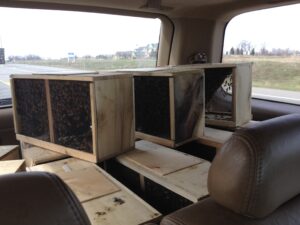In speaking at several bee schools lately, I am frequently asked whether I think someone should begin with a nuc (nucleus hive) or a package.
The answer is yes! I encourage everyone to keep bees, so yes, you should begin with one of those two predominant methods of obtaining bees. Or begin with both of them. 🙂
Seriously. It is widely recommended that you start with at least two hives. That’s not only an education twice as fast, but your chances of success improve because resources can be shared between the colonies should problems arise. A frame of brood and nurse bees from a strong hive can help a challenged hive build up a bit quicker, for example.
But, if your budget only allows for one hive, should you start with a nuc or a package of bees? That’s an individual choice, depending upon your circumstances. But, here are some considerations. And, if you’re unsure about what a nuc is versus a package, I’ve defined those below as well.
The key things – just do it. Like anything in life—buying a house, having kids—if you wait until you fully understand all it entails and how to do it, you’ll never be in a position to do it. Just do it! 🙂

Last year we picked up 27 packages for us and several newbees we were mentoring. It was an interesting ride home, as there were more hitchhikers than we realized.
Pros of packages versus nucs:
- Packages are generally more obtainable. Historically suppliers have sold out of nucleus hives before they sell out of packages, although packages often sell out as well.
- Packages are usually obtainable earlier in the season. Nucleus hives take time to build-up and prove their viability unless they are developed south of here. For the first time in my limited beekeeping history, I know of nucs that will be available about the same time as package bees.
- Packages allow you to experience more of the build-up—watching comb being drawn out, the thrill of finding eggs, watching them turn into larva and seeing “your queen” come online as the head of a successfully growing colony. Explained one beekeeper “I started with a package because my grandkids were involved. We could watch them build up slowly, and 10,000 bees is plenty scary. A package sort of let us ease into it.”
- Packages are typically cheaper than nucs. I’ve heard of packages for about $100 and nucs for about $150 this season, although I’ve seen packages as low as $95, and nucs as high as $200.
Cons of packages versus nucs:
- They’re most likely not local stock, and therefore, may not be best-suited for our climate.
- They may be under duress from travel.
- There are key things to do in the first few weeks—ensuring the queen gets out of the cage, ensuring the queen is laying properly, and of course, feeding the colony. Those are critical … and can’t be done from Florida where you understandably escaped for a spring vacation. If your schedule won’t allow you to get into your hive(s) about weekly for the first month, you may want to get a nuc.
- Packages may have problems—a dead queen, a poorly mated queen, etc. While solvable, they may be difficult for a newbee to discern and correct. A nuc from a reputable supplier is already off and running, a proven working-together unit.
- A package comes with no resources. If conditions aren’t good (nothing to forage, cold and rainy) they will require a lot of nurturing. A beginner may not have the equipment, tenacity, availability or understanding to provide what they need.
- Packages tend to swarm more than nucs, because a new house doesn’t have the appeal of a functioning home. I’ve installed over 200 packages with folks over the years; I know of it happening only a handful of times. Still a very small percentage, but I wanted to mention it nonetheless.
Definitions
- A “package” contains about three pounds (10,000 insects, mainly worker bees but some drones as well), and a queen in a cage who is not related to the bees in the package. The queen is allegedly mated and ready to produce.
- A “nucleus hive” a colony of bees already working together. The queen is recognized by the workers and drones as Their Queen Bee; she is the mother of probably most of them. She is laying eggs at a rate appropriate to the work force, and they’re tending them well. The brood is in various stages of development, from egg to larvae to capped. The colony has drawn comb for the bees-to-be and has already stored pollen, nectar and likely even honey in it. Everything in the nuc has proven to be working well together. All they need is more space, in due time.
